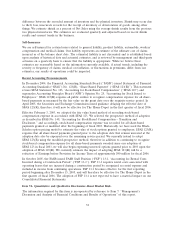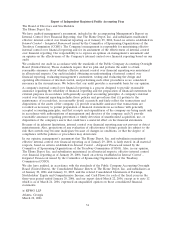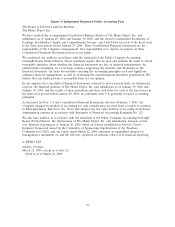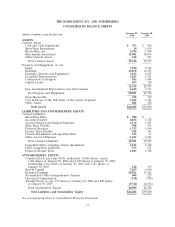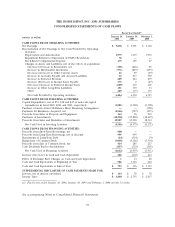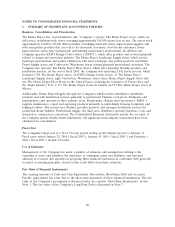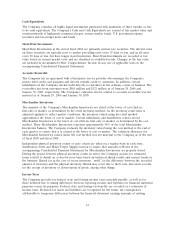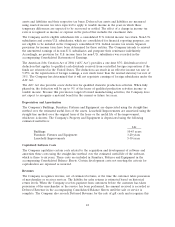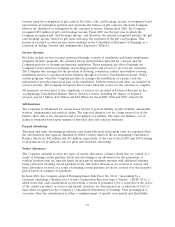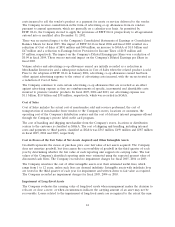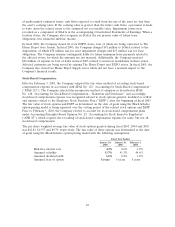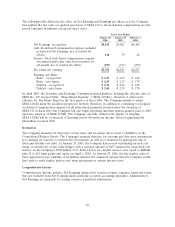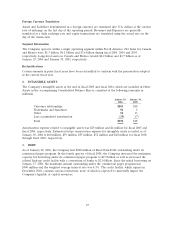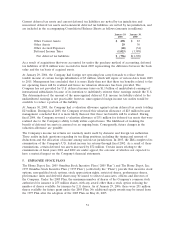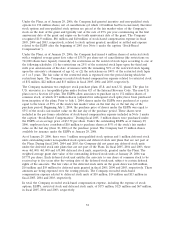Home Depot 2005 Annual Report Download - page 54
Download and view the complete annual report
Please find page 54 of the 2005 Home Depot annual report below. You can navigate through the pages in the report by either clicking on the pages listed below, or by using the keyword search tool below to find specific information within the annual report.
assets and liabilities and their respective tax bases. Deferred tax assets and liabilities are measured
using enacted income tax rates expected to apply to taxable income in the years in which those
temporary differences are expected to be recovered or settled. The effect of a change in income tax
rates is recognized as income or expense in the period that includes the enactment date.
The Company and its eligible subsidiaries file a consolidated U.S. federal income tax return. Non-U.S.
subsidiaries and certain U.S. subsidiaries, which are consolidated for financial reporting purposes, are
not eligible to be included in the Company’s consolidated U.S. federal income tax return. Separate
provisions for income taxes have been determined for these entities. The Company intends to reinvest
the unremitted earnings of its non-U.S. subsidiaries and postpone their remittance indefinitely.
Accordingly, no provision for U.S. income taxes for non-U.S. subsidiaries was recorded in the
accompanying Consolidated Statements of Earnings.
The American Jobs Creation Act of 2004 (‘‘AJC Act’’) provides a one-time 85% dividends-received
deduction that applies to qualified cash dividends received from controlled foreign corporations if the
funds are reinvested in the United States. The deduction can result in an effective income tax rate of
5.25% on the repatriation of foreign earnings, a rate much lower than the normal statutory tax rate of
35%. The Company has determined that it will not repatriate earnings of foreign subsidiaries under the
AJC Act.
The AJC Act also provides a new deduction for qualified domestic production activities. When fully
phased-in, the deduction will be up to 9% of the lesser of qualified production activities income or
taxable income. Because this provision is targeted toward manufacturing activities, the Company does
not expect to recognize a material benefit in the current or future tax years.
Depreciation and Amortization
The Company’s Buildings, Furniture, Fixtures and Equipment are depreciated using the straight-line
method over the estimated useful lives of the assets. Leasehold Improvements are amortized using the
straight-line method over the original term of the lease or the useful life of the improvement,
whichever is shorter. The Company’s Property and Equipment is depreciated using the following
estimated useful lives:
Life
Buildings 10-45 years
Furniture, Fixtures and Equipment 3-20 years
Leasehold Improvements 5-30 years
Capitalized Software Costs
The Company capitalizes certain costs related to the acquisition and development of software and
amortizes these costs using the straight-line method over the estimated useful life of the software,
which is three to six years. These costs are included in Furniture, Fixtures and Equipment in the
accompanying Consolidated Balance Sheets. Certain development costs not meeting the criteria for
capitalization are expensed as incurred.
Revenues
The Company recognizes revenue, net of estimated returns, at the time the customer takes possession
of merchandise or receives services. The liability for sales returns is estimated based on historical
return levels. When the Company receives payment from customers before the customer has taken
possession of the merchandise or the service has been performed, the amount received is recorded as
Deferred Revenue in the accompanying Consolidated Balance Sheets until the sale or service is
complete. The Company also records Deferred Revenue for the sale of gift cards and recognizes this
42


